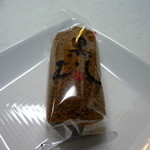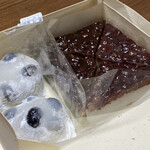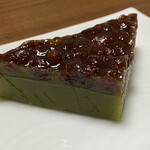
仙太郎 本店
Sentarou ◆ せんたろう
3.21
Kawaramachi, Kiyamachi, Ponto-cho
「Japanese Sweets」
--
--
Opening hours: 8:00-18:00 Open Sundays
Rest time: Open daily Open hours and holidays are subject to change, so please check with the store before visiting.
京都府京都市下京区寺町通り仏光寺上る中之町576
Photos
(20)




















Details
Children
child-friendly
Payment Method
No credit cards
Electronic money is not accepted
Number of Seats
(There are only two benches)
Private Dining Rooms
None
Smoking and Non-Smoking
No smoking at the table
Parking
None
Facilities
Calm space
Comments
(20)
alphaville18st
4.50
Seasonal item: sweetfish. It's a young sweetfish with a chewy texture that is irresistible. It's not something you eat often, so it's not readily available at supermarkets; you have to patiently wait for it. It makes a great gift. Bamboo water: it's more like a drink than a water yokan. It has a refreshing taste with a smooth and light bamboo fragrance.




a63bc9
3.50
On June 30th, in Kyoto, there is a custom of eating "Minazuki" in relation to the summer purification ceremony. Minazuki is a traditional Japanese sweet made with three layers - white, black sugar, and matcha - resembling ice shards. The base of Minazuki is made of mochi, symbolizing ice, with red beans scattered on top believed to ward off evil spirits and bring good health.


PINNACLE
3.50
I purchased kinako and anko ohagi. The kinako ohagi has smooth red bean paste inside. Both varieties have chopped shiso mixed in the rice cake, giving it a refreshing flavor. It was my first time trying them, and I found them delicious, with the shiso helping to balance out the sweetness of the anko. Thank you for the meal.

tokamyama
3.30
Today, I bought black bean daifuku from this shop to enjoy on the way home on the Shinkansen. The mochi of the daifuku is very soft, and the large black beans have a strong impact while being delicious. Kyoto has a lot of delicious traditional Japanese sweets, which makes me envious.


ひとちゃんpe
4.50
At the end of my trip to Nagoya, I stopped by here. I had planned to buy some outside, but the long line caught my attention. I ended up buying two types of sakuramochi, monaka, and ohagi. While the monaka was delicious, I was particularly impressed by the sakuramochi. It was so delicious that I could eat three at once. I will definitely stop by here whenever I come to Nagoya!


mogu2nobu
3.80
While walking around the vicinity of Kawaramachi in Kyoto, I stumbled upon a familiar store, the main branch of Sentaro, famous for its young sweetfish. They also had sakura mochi available at the time, so I decided to take some to go. The mochi was made of translucent rice and filled with a refined sweet bean paste. The salted sakura leaf added a nice touch to the flavor. It was truly delicious. Although the cherry blossom dumplings also looked appealing, I had to pass on them due to limited stomach capacity. The interior of the store was calm and had a nice atmosphere. Thank you for the meal.




まいちゃろちゃん
3.30
Admired Sentaro Main Store
Sentaro♡Kyoto❤️ Kawaramachi♡my pick! ・Hanagun ・Flowers and Dango ・Sakuramochi♡In March, the department stores in Kyoto are lined with various cherry blossom sweets ( ⸝⸝•ᴗ•⸝⸝ ) There are many delicious pink sweets, but among them, Sakuramochi is exceptional for me. Every year as spring approaches, I look forward to trying various cherry blossom sweets from different shops. This time, I went around different shops searching for delicious Sakuramochi. I came across the famous Kyoto confectionery shop "Sentaro" and their Sakuramochi. Established in 1886, Sentaro is a long-established shop with over 100 years of history. They have outlets in various department stores, and I always remember the crowds of people gathering there. So, what does Sentaro's Sakuramochi taste like? I also bought other limited spring products to review.
When it comes to Sakuramochi, there are actually two main types: Kanto-style (Chomeiji) and Kansai-style (Daifuku). Kanto-style is a crepe-like confection made with wheat flour dough rolled with sweet bean paste. It is said to have originated from Chomeiji in Tokyo. On the other hand, Kansai-style Sakuramochi, also known as Daifuku, is made with mochi using glutinous rice flour and filled with sweet bean paste. In Kansai, Sakuramochi refers to the Kansai-style Sakuramochi shown in the picture. Sentaro is a Kyoto confectionery shop, so their Sakuramochi is the Kansai-style Sakuramochi. Unlike the typical pink Daifuku with cherry blossom leaves, Sentaro's Sakuramochi is different. The Daifuku is white in color. The Sakuramochi features two cherry blossom leaves, which is more than the usual one leaf seen in other Sakuramochi. The reason for this is explained. White Daifuku tends to pale in comparison to pink ones, so the two leaves are used to camouflage the white color.
Upon opening the box, a faint cherry blossom scent wafts out. The majestic Oshima cherry blossom leaves fill the box, and the sight is impressive. The green leaves seem to exude a powerful energy. The wrapping is also beautiful. Just looking at the leaves makes me happy. I would love to devour it in one bite, but I wanted to see what's inside, so I decided to eat it slowly. The cherry blossom leaves are moist, releasing a wonderful cherry blossom scent. A slight saltiness is also detected in the aroma. The fine-grained surface of the Daifuku is glossy and sparkling. The first thing you notice is the sharp saltiness that tingles the tongue. The cherry blossom leaves are salted, hence the slight saltiness.

ka2o ryo
3.70
The basement of the department store was quite crowded, but the main store was relatively empty. I tried Hanabira mochi for the first time and it was delicious, with the mochi and white bean paste being tasty. I realized that I may actually like white bean paste. The hotel is also nearby, and there is a coffee shop nearby as well, which is convenient.


goldpink
3.60
I don't really like ohagi, but the only one I find delicious is at Sentaro. It has shiso inside the sticky rice, so it's refreshing and easy to eat. The combination of shiso and sweet bean paste is interesting. It's located inside Mitsukoshi Ginza in Tokyo, so it's available in major cities nationwide. Enjoy it freshly made right away.

glot
3.60
I finally visited the main store of Sentaro, which my grandmother loves. I was a little worried that there might be a long line like at the Hankyu Sentaro, but there was no line, so I felt relieved. However, the store seemed busy with customers coming and going constantly. I bought some Ohagi, which was small and I thought that perhaps the ones in Kyoto are more elegant in size compared to those in Osaka. I also tried the Tsukimi Dango, which was very delicious.



yossy1
3.80
Senbataro in Kyoto is highly recommended for traditional Japanese sweets. Their seasonal item "Take no Mizu" is a smooth and sweet water yokan that is perfect for summer. The "Kuromame Daifuku" is a summer staple with firm black beans and a well-balanced sweetness. Another popular item is the "Minazuki," available in both white and matcha flavors, both offering a smooth and delicious texture.




アキタン34
3.50
These are two star-shaped wagashi sweets inspired by the stars Hikoboshi and Orihime. They are quite sweet with two types of sweet bean paste. The jelly on top gives a refreshing feeling. I also bought Mizunomizu and sakura kuzumochi. The sakura-scented kuzumochi had a good balance of red bean paste and kuzu. The Mizunomizu had a strong matcha flavor and was delicious.


Akio I
3.60
Settled in a familiar department store, Sendo Sato is a well-known establishment. I visited the main store located a little south of Shijo Street for the first time. I was looking for Minazuki, which comes in three varieties: white, black, and matcha. Each one costs 238 yen. While the black with brown sugar flavor is tempting, my preference leans towards the basic white. It is characterized by a strong sweetness from large red beans. It may be a little early, but this was our summer purification ritual at home.




千本桜はんひち
3.80
Sentaro's Dorayaki❣️ Dorasenta-chan is riding on top of a thousand horses? It's a joyful picture for the Thousand Cherry Blossoms (#^.^#) At the storefront, Ohagi is popular too, but it doesn't last long, so Dorayaki is good for souvenirs. This day, everyone enjoyed eating and it disappeared in no time. They use domestically sourced ingredients, and the sweetness comes from Hokkaido beet sugar. Finally, in Heisei 15, their wish came true and they switched to Hokkaido sugar. The coarse sweet bean paste is made from their own farm's Tanba Dainagon beans, cooked slowly for 2 days and nights. It's quite close to my house, near Nantan Yagi. They also sell directly at the factory, which I recently reviewed. It's a great shop, with a strong connection to the land. I used to come to Kyoto for work when I was young, and I've been a fan of Sentaro since then. In the past, there was only the main store near Fujii Daimaru, but recently they have opened in various department stores, all with long lines.




食いしん坊プリンセス
3.80
This is a shop located southwest of Kyoto Kawaramachi Station in Shimogyo-ku, Kyoto. Established in Meiji 19. A long-established Japanese confectionery shop in Kyoto with its own farm in Tango. #Today's snack ★ Ohagi Grain 1 piece 195 yen ★ Yomogi Mochi 1 piece 238 yen Ohagi is delicious with the refreshing taste of perilla mixed in the glutinous rice enhancing the elegant sweetness of the anko. It has a refreshing aftertaste that makes you want to eat as many as you can. Yomogi Mochi is a limited-time product until April 6th. The mochi dough kneaded with mugwort is filled with grain anko, and even before you put it in your mouth, the good smell of mugwort spreads, and the taste is also delicious. Thank you for the meal ❤︎ (⁎ᵕᴗᵕ⁎)




東行晋作
3.80
I received "Fukumasu" from a friend in Kyoto for Setsubun. "Sentaro" is a popular Japanese confectionery shop founded near Kawaramachi in Kyoto in Meiji 19. The Setsubun confectionery "Fukumasu" from "Sentaro" comes in a wooden masu with a red demon packaging, and a rubber band is attached to use as a demon mask. When you open the lid, there are colorful auspicious Japanese sweets inside. The Setsubun confectionery in "Sentaro" includes: Peach Mountain Good Luck Beans, Black Bean Sweetened Red Beans, and Three-color Suhama Balls. The beans used for Setsubun bean throwing are called "Fukumame." Let's destroy the evil eyes of Corona by eating "Sentaro's" Fukumame. - Out with the demon, in with good luck - ε=ε=ε=ε=ε=ε=ε❗️




tak98002
3.60
This shop is where I stop by when I crave something sweet. Their ohagi and monaka are absolutely delicious. I always buy enough for my family as well. The ohagi has a hint of shiso which adds elegance to the sweetness of the red bean, making it really tasty. The monaka is filled with rich and sweet red bean paste, giving it a satisfying and filling taste. I'm happy that there are so many delicious traditional Japanese sweets that are easy to buy in Kyoto.




せいらんこ
3.40
I finally got to eat mitarashi dango in the evening, as they are usually sold out by then. The mitarashi dango was soft even though some time had passed. The sauce was a bit thick. The sakuramochi was white instead of pink. The sakura kuzumochi was good. The sweet bean daifuku, kinako ohagi were also good.

comotan
3.60
I visited a traditional Japanese confectionery shop located on Teramachi Street in Shimogyo-ku, Kyoto today.
Sen-taro Main Store
This is the main store of "Sen-taro," a popular confectionery shop with branches in Kyoto and department stores nationwide. I visited again today around noon as the popular "Seven-Grain Ohagi" was sold out last time. This season, there were four types of ohagi available, each priced at 195 yen (tax included). Luckily, I managed to get the last "Seven-Grain Ohagi." The ohagi was packed in a special box for me to take home, with a consumption period until the end of the day.
I purchased three colorful ohagi:
- Ohagi with Sweet Bean Paste: A basic type of ohagi wrapped in sweet bean paste. Under the red bean paste, there was sticky rice with shiso leaves as an accent. It was delicious.
- Ohagi with Kinako and Black Soybeans: This ohagi was wrapped in kinako with black soybeans mixed in. The kinako ohagi had smooth sweet bean paste inside, wrapped in shiso sticky rice, and further coated in black soybean kinako. The three layers created a flavorful experience.
- Seven-Grain Ohagi: This ohagi was made with black soybeans, millet, barley, adlay, azuki beans, and sticky rice. Like the others, it also had shiso leaves inside. It contained whole bean paste and offered a fun mix of textures from various grains. It's no wonder this is a popular choice.
I thoroughly enjoyed the ohagi from Sen-taro once again today.




comotan
3.50
Today, I stopped by a traditional Japanese sweets shop on Teramachi Street in Kyoto. Sen-taro is a popular shop known for their monaka and ohagi, with locations in Kyoto and nationwide department stores. I visited their main store on Teramachi Street after a friend recommended their ohagi to me. I arrived a bit late, so there were only two types of ohagi left. I purchased both and tried them out.
- Ohagi (Kinako): This ohagi is made with black bean kinako. The kinako had some black grains mixed in, giving it a unique texture. It was wrapped in sticky rice with red bean paste, and coated with kinako. It was more flavorful and delicious than regular kinako ohagi.
- Ohagi (Sesame): This was a limited edition ohagi available only in February. It also used sticky rice with red bean paste, and was coated in black sesame seed paste. The sesame flavor was distinct and it was simply delicious.
I enjoyed both ohagi, especially the use of red shiso leaf in them.




Email Login